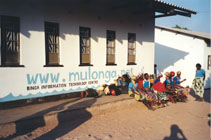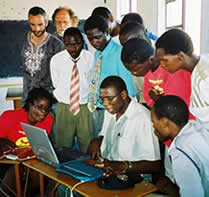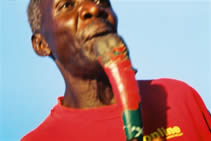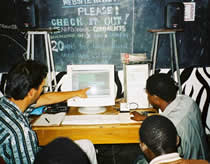|
Back to Index
MULONGA:
The Tonga.Online Project
Keith Goddard
in discussion with others involved in the Tonga.Online project
June 02, 2004 (This article was originally written in September 2002)
Visit the Tonga.Online
website at www.mulonga.net
A collaboration
between the Austria-Zimbabwe Friendship Association (AZFA) in conjunction
with KUNZWANA Trust (Harare, Zimbabwe) and the Valley Tonga using the
medium of culture.
  The
Tonga.Online project www.mulonga.net,
represented at Ars Electronica Festival 2002, is the most recent phase
in an extended cultural relationship between the Zimbabwe-based KUNZWANA
Trust (in conjunction with the Austria-Zimbabwe Friendship Association)
and the Tonga of the Zambezi Valley who live on both sides of the border
between Zambia and Zimbabwe. The springboard was the people of Siachilaba,
a village 60 km from the main town of Binga, and in particular the Ngoma
Buntibe music of the group called Simonga. The
Tonga.Online project www.mulonga.net,
represented at Ars Electronica Festival 2002, is the most recent phase
in an extended cultural relationship between the Zimbabwe-based KUNZWANA
Trust (in conjunction with the Austria-Zimbabwe Friendship Association)
and the Tonga of the Zambezi Valley who live on both sides of the border
between Zambia and Zimbabwe. The springboard was the people of Siachilaba,
a village 60 km from the main town of Binga, and in particular the Ngoma
Buntibe music of the group called Simonga.
The Valley Tonga are
the third-largest ethnic group in Zimbabwe and some of the most marginalised
people in the country. In the past they were largely cut off from the
benefits which accrue to other Zimbabweans, especially those in urban
areas. In 1957 they were forcibly removed from the shores of the Zambezi
River to make way for the building of Kariba dam which brought electricity
to the rest of Zimbabwe (then Southern Rhodesia) and huge commercial benefits
to the nation in the form of tourism around the lake. Until the early
1980s which saw the building of schools, clinics and roads, these benefits
all but completely bypassed the Tonga.
Much has been said
about the harm done to the Tonga through displacing them and abandoning
them on arid land. The social disruption was a cataclysm with families
being split and members cut off from each other because of the barrier
presented by the dam and, in 1964, the new political border with Zambia.
To add insult to injury, the Tonga were stigmatised as dangerous, deformed,
sub-human and practitioners of witchcraft who hate outsiders. During the
time of the British settler regime, they were looked upon as occupants
of some kind of human national park to be preserved like game for the
amusement of tourists. Whilst these myths and crimes of the past need
to be exposed, the constant harping on about past ills has its draw backs,
the most serious being that it feeds into the victim-perpetrator mentality
that has colonised the minds of millions in the so-called developed world
and has also colonised the minds of millions in Africa.
The avoidance of begging
bowl politics is why the KUNZWANA/AZFA cultural relationship with the
Tonga has little to do with humanitarian aid. It has not involved food
drops, grinding mills or the building of clinics. It is founded on the
principle that cultural identity forms a vital function in terms of human
survival. When forcibly removed to make way for the building of Kariba,
the Tonga lost everything including the fixed assets of their material
culture such as their shrines. Their cultural styles were automatically
transported with them because they filled no extra space and could not
anyway have been separated from the bodies being moved. The Tonga maintained
their identity by organising around what remained of their culture and,
because the culture was dynamic, it helped them face and adapt to the
massive challenges that their new environment presented them. Put very
simply, the Tonga invested heavily in their culture and this meant they
survived.
MULONGA - THE LOOP
: Reclaiming and broadcasting of Tonga Ngoma Buntibe music as the focus
of Tonga.Online during the Ars Electronica Festival 2002
Strangely enough, the enforced move provided the Tonga with a small jewel.
Shortly before the flooding, the ethnomusicologist, Hugh Tracey, was invited
to the valley by the Livingstone Museum to record on tape examples of
what were believed to be the last vestiges of Tonga culture before it
vanished for ever. He recorded over sixty examples of Tonga music. Previously
these recordings were unavailable to the culture that produced them. Now,
through the South African International Library of African Music (ILAM)
website and the newly established internet connection in Binga, this historical
legacy, which was transferred from analogue tape to vynal record and more
recently digitalised and stored for safety reasons in a Norwegian mountain
inside the Arctic Circle, has the potential to be reclaimed by the people
of the Zambezi valley.
  This
reclamation is expressed during the Ars Electronica Festival through the
process of a loop. The 1957 recordings are downloaded from Norway to ILAM
in South Africa and then streamed to Linz and transmitted to SW Radio
in London which broadcasts to Zimbabwe. People in Binga hear the recordings
and then, through a series of interviews, comment on them through a phone
link to SW Radio. These reactions are broadcast to Linz and form the basis
for further discussion and reflection in both Binga and Linz during the
festival, especially through the Radiotopia global network of artistic
communication. This
reclamation is expressed during the Ars Electronica Festival through the
process of a loop. The 1957 recordings are downloaded from Norway to ILAM
in South Africa and then streamed to Linz and transmitted to SW Radio
in London which broadcasts to Zimbabwe. People in Binga hear the recordings
and then, through a series of interviews, comment on them through a phone
link to SW Radio. These reactions are broadcast to Linz and form the basis
for further discussion and reflection in both Binga and Linz during the
festival, especially through the Radiotopia global network of artistic
communication.
The style of the cultural
collaboration between KUNZWANA/AZFA and the Tonga people has sometimes
met with severe criticism. Referring to a 1997 concert of reflections
on Tonga music by six contemporary music composers which took place in
Siachilaba, some people asked what the point was in bringing obscure electro-acoustic
music to the Tonga when local bands have no instruments. They queried
the expense involved and the appropriateness of bringing to the Tonga
a music which to many western ears is symptomatic of the cultural decay
of the so-called developed world. One person asked angrily why we did
not spend the money on fixing the broken grinding mill at the local business
centre.
A few years later
they also questioned the importation of dozens of computers into schools
where there are no basic text books or stationery. They asked why thousands
of Austrian shillings were spent on bringing large numbers of Tonga musicians
to Austria when children have to walk 12 kilometres to school every day.
Now they are questioning why an internet project is being introduced to
a rural population when people there have asked for income-generating
projects for basket makers or a new clinic.
Human beings are more
than bodies with stomachs to feed. We are also thinkers with ideas. The
journey of the 30-member Ngoma Buntibe group, Simonga, to the 1997 Festival
of the Regions in Upper Austria and the voyage over the Totes Gebirge
(a Stadtwerkstatt Kunst und Krawall project) emphasised the beauty, distinction
and resilience of the musical culture, in particular the Nyele horns of
Ngoma Buntibe music. The musical texture of these horns debunked the myth
of Africa being the continent of bongo drums where everyone has rhythm:
Simonga in Austria would not have sounded out of place in the concert
halls of any contemporary music festival. In addition, the presence of
the musicians in Austria raised the profile and gave visibility to the
Tonga in an unprecedented way.
  The
linear view of history and development that suggests stone must precede
paper, paper precede computer and computer precede internet, is dangerous
and simply deepens the divide between the haves and have-nots. Text books
are expensive; most information available over the net is free. It makes
perfect sense for the Tonga to leapfrog over the paper revolution and
enter directly into cyberspace. The
linear view of history and development that suggests stone must precede
paper, paper precede computer and computer precede internet, is dangerous
and simply deepens the divide between the haves and have-nots. Text books
are expensive; most information available over the net is free. It makes
perfect sense for the Tonga to leapfrog over the paper revolution and
enter directly into cyberspace.
The grinding mill
mentality is one of the worst expressions of patronage. This was borne
out when a local business did the job herself. Joyce Mangoro installed
electricity at the business centre, fixed the existing grinding mill and
built a second one. The mills work because they belong to an enterprise
that has a vested interest in ensuring they are properly maintained.
Nevertheless, in terms
of social development, there have been a number of collateral benefits
(or positive side effects) which have resulted from the collaboration.
In terms of building up infrastructure, electricity will be installed
at a school in Siachilaba in order to accommodate the second internet
centre in the area. In terms of economic trade, a class in a business
school in Linz-Auhof now runs a project called Auhof Basket Company (ABC)
which imports and promotes Tonga baskets from the Binga Craft Centre.
In terms of the music business, payments for a CD and performances of
Simonga also mean general improvements in living standards.
One of the threats
of globalisation is that the less powerful run the risk of being overwhelmed
by the more powerful. But we need to be careful about censoring what we
communicate and share because of some misguided belief that it will recolonise
minds that are vulnerable and unprepared. If we decide on what is suitable
for the Tonga to consume and to experience, we put ourselves on the same
level as those who patronise Africa as the continent of the begging bowl.
By maintaining the attitude that the Tonga are to be preserved and left
to their own separate development smacks of apartheid and continues to
propagate the exotic myths of racial and sexual others that were used
by colonialism to subjugate the colonised and keep the colonisers safe
from what was called racial contamination. Besides, nobody can stop globalisation:
it is not possible to stem the tide of history even if some want to and
think that they can. The idea of the internet expresses the human right
of everyone to receive and impart information: our accompanying responsibility
is to ensure that its expansion is properly shaped and that the powers
and advantages globalisation brings are available to all and not just
to a privileged elite. At the moment, access remains extremely uneven.
The Tonga.Online project
has been viewed by some as a luxury gimmick. Connecting the exhibition
'Tracing the Rainbow' at Landesmuseum in Linz with the Tonga initially
seemed an expensive and bizarre idea with no visible benefit accruing
to the Tonga. By the end of January 2001, it was clear that not only was
internet connectivity wanted in the area but that Binga High School had
a room prepared and was simply looking for the computers to fill it.
The mulonga website
has raised issues regarding representation. It was designed by Austrian
artists, Sabine Bitter and Helmut Weber. It is text-based and structured
around a series of discussion platforms which encourage debate. Bitter
and Weber were conscious of the pitfalls of representing communities as
the exotic others rather than communities representing themselves. During
the exhibition a few work stations were set up in a sparsely furnished
room. The project focused on one simple word: communication. In contrast
to much of the rest of the exhibition which displayed huge numbers of
subtly-lit artefacts, the Tonga.Online project room, designed by Thomas
Schneider, used bold neon lighting. Discussions going on over the web
were pinned to the walls during the exhibition. Pictures on the walls
were kept to a bare minimum and images confined to few video loops.
Representation and
visibility at Ars Electronica Festival present a number of management
problems for Tonga.Online. At the symposium, Dominic Muntanga, as a Tonga
representing Bwaaca Trust, can speak with authority (albeit as a relatively
privileged person within his community) but I am white, live in Harare
and do not speak Tonga. Although I have been involved with the people
of Siachilaba for over ten years, my full-time work at present is not
in music but in the field of human rights and sexuality. Considering these
issues, it was decided to structure the session in the form of an interview/discussion.
  Elsewhere
during the festival, Tonga.Online is represented through a number of reference
points: in Radiotopia, in the Klangpark and on Radionight and through
a few physical work stations linked to the mulonga website. But in real
space streaming, where huge amounts of information are being transmitted,
there is competition for space. The difficulties are exacerbated by simple
differences of bandwidth: the telephone lines in Binga do not allow for
the transmission of large amounts of information. The project, therefore,
still needs to fight for visibility and attention and ensure that its
message is clear and understandable. To compound the difficulties, the
project is not physically at Ars Electronica Festival but somewhere else
in the world. Tonga.Online needs to ensure that the community in Binga
has equal opportunity to be directly involved with its representation
at the festival and does not get represented. Elsewhere
during the festival, Tonga.Online is represented through a number of reference
points: in Radiotopia, in the Klangpark and on Radionight and through
a few physical work stations linked to the mulonga website. But in real
space streaming, where huge amounts of information are being transmitted,
there is competition for space. The difficulties are exacerbated by simple
differences of bandwidth: the telephone lines in Binga do not allow for
the transmission of large amounts of information. The project, therefore,
still needs to fight for visibility and attention and ensure that its
message is clear and understandable. To compound the difficulties, the
project is not physically at Ars Electronica Festival but somewhere else
in the world. Tonga.Online needs to ensure that the community in Binga
has equal opportunity to be directly involved with its representation
at the festival and does not get represented.
The Tonga presence
at Ars Electronica Festival, however, provides fresh platforms for debate
centring on whether the project is really a vehicle for art production
or simply an amorphous, unfocused and pretentious social project masquerading
as art. Perhaps these are niceties to occupy western European artists
whilst the Tonga see the internet as a practical technological tool for
social development but Tonga.Online is not confined to one space; it exists
in Binga and it exists in Harare, in Linz and in Vienna, places which
differ hugely from each other in conceptual thinking. Mulonga has become
one of the major sites for shaping negotiation between these geographical
sectors and the politics of space.
For something to be
a cultural construction, it needs to have identity and it needs a frame
otherwise there is no opportunity for critical evaluation. Tonga.Online
is obviously only one corner of a much larger space involving creative
exchanges between musicians and artists in Austria and Zimbabwe, each
of which has its individual framework and reference points. Its presence
at Ars Electronica Festival continues the theme of communication but now,
because the Tonga are genuinely online, this theme expands into questions
around oral tradition and ways in which communities like the Tonga have
been storing and organising information and communication in the past
versus organising information and communication using the internet.
If nothing else, Tonga.Online
is using the space provided by the Ars Electronica Festival to dramatise,
through means of the Mulonga loop and the feedback within it, a specific
example of how technology can be used to reclaim history. This is poignant
when you think that the net continues to be one of the vital tools for
communicating in nations throttled by ever-increasing restrictions on
people's rights to information and in communities which are often seriously
misrepresented in other parts of the world.
Visit the Kunzwana
Trust fact
sheet
Please credit www.kubatana.net if you make use of material from this website.
This work is licensed under a Creative Commons License unless stated otherwise.
TOP
|

